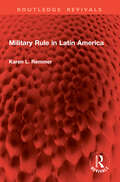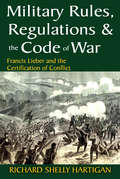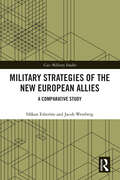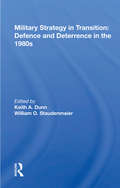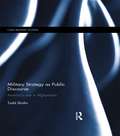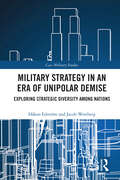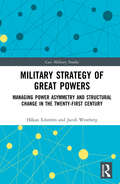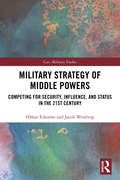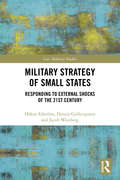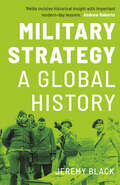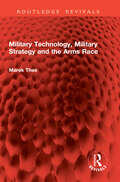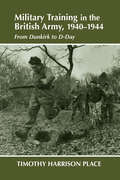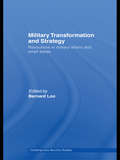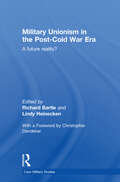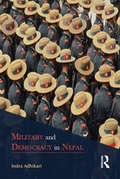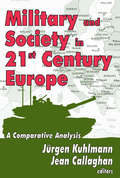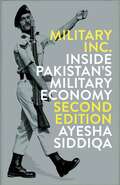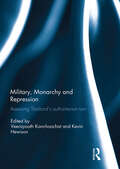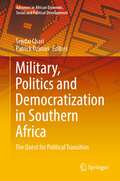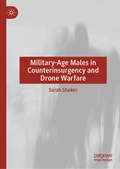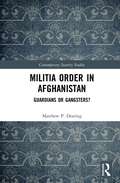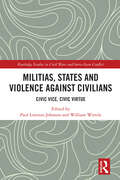- Table View
- List View
Military Retirees: An Analysis Of Their Settlement In Foreign Lands With Emphasis On Central America And Mexico
by Phillip AllmanPast severe winters experienced in the United States, combined with escalated fuel prices and other unattractive conditions such as higher taxes, inflation, crime, urban decay, etc., have forced numerous American retirees south to more climatically favorable and economically amenable areas. Many have ventured into foreign lands in search of these amenities and some have established retirement residency in the nations south of our international border. Among these adventurous retiree migrants are significant numbers of American military retirees who have histories of extensive foreign travel and residence during their military careers. This book is about that migrant group and its settlement in Central America and parts of Mexico. It examines the places where these migrants have settled, determines why they have chosen those specific places for retirement, describes their characteristics, explains how the migration takes place, and discusses its consequences. Also, it provides a brief history of United States military personnel in foreign areas, with emphasis on the relationship between their frequent relocation and their propensity to migrate after retirement, and describes the world distribution of the 1.2 million members that comprise the military retiree population.
Military Rule in Latin America (Routledge Revivals)
by Karen RemmerFirst published in 1989, in Military Rule in Latin America Karen L. Remmer draws upon a wide variety of sources, including interviews with top government officials, to challenge prevailing interpretations of military rule. She questions the assumption that military regimes can be adequately understood in terms of their origins and shows how important variations among them reflect the roles of state actors and institutions.In the first part of the book, Remmer provides a broad overview of military rule in Latin America; in the second, a detailed case study of Chile under the Pinochet regime. She concludes by examining the implications of her findings for understanding transitions from authoritarianism and the consolidation of democracy. This groundbreaking work is essential reading for scholars and researchers of Latin American studies, political studies and comparative politics.
Military Rules, Regulations and the Code of War: Francis Lieber and the Certification of Conflict
by Richard Shelly HartiganMilitary commanders from ancient time had set down rules and regulations to discipline their troops. From the Pharaohs on, commanders directed the strategy, tactics, and camp discipline of the often unruly hosts of soldiers under their command. They had one aim: to create an efficient fighting force. Military officers, camp-followers and cooks were all expected to perform their services according to mandate and in light of the best interests of the armed force and the fighting soldiery. Modern commanders have exemplified the same passion for military discipline to produce an effective combat machine. Military analyses derived from Roman law contained enough historical examples to fill an encyclopedia. Yet, although addressed to the problems of their day, they generally remained the private counsel of scholars and had little impact on political and military decisions. While theorists of international law were developing a body of rules to govern warfare, practitioners of conflict were largely moved by the motives of military necessity. Under the dual auspices of military necessity and national self-interest, the code of the military commander was simple: maintain a disciplined fighting force in order to achieve military victory. To remedy this gap between theory and practice, a practical guide was needed which would briefly describe for commanders in the field their rights and obligations of belligerents as custom and theory had developed them. Then political and military policy could be expected to conform to the theoretical law of nations. This was the synthesis that the Lieber code proposed. Originally published in as Lieber's Law and the Code of War, this paperback edition bears a new title that more precisely identifies the subjects covered.
Military Social Work Around the Globe (Military and Veterans Studies)
by Mary Ann Forgey Karen Green-HurdleThis is the first book to focus on the scope of social work practice within military settings from an international perspective, and therefore addresses what has been a significant gap in the literature. Given the critical support needs of military personnel and their families worldwide, and the expanding role of social work in responding to these needs, this book offers a comprehensive global understanding of the common military social work (MilSW) practices with active duty military service members and their families, as well as the forms of practice and approaches that are unique, or potentially transferable across nations.Based on a systematic inquiry conducted by the Editors, there are at least 25 countries that have social workers working directly within their country’s military in either a civilian or uniformed capacity, or both. This book includes contributions from experts in Australia, Canada, Denmark, Finland, Ireland, Israel, the Netherlands, New Zealand, South Africa, the UK, and the USA, who describe various aspects of the MilSW role within their country and the research that informs what military social workers do. The MilSW similarities and differences among these countries are highlighted, including developmental milestones, practice settings, practice orientation and approach, ethical dilemmas, military to veteran transition support, and past and current challenges. Experts from countries that do not yet have MilSW but are interested in developing it (Japan, Ukraine) or are in the process of establishing this area of practice (Slovakia), also contribute chapters about these developments and the evidence base that supports this direction.Military Social Work Around the Globe is a valuable resource for social work programs and essential reading for instructors and students in MilSW electives and specializations. It is also pertinent reading for occupational social work and international social work courses. In addition, this book is an important source of information for military social workers who would like to gain insights into existing programs and the possibilities for international collaboration, and for countries interested in developing MilSW.
Military Sociology: A Guided Introduction (Sage Library Of Military And Strategic Studies)
by Wilbur J. Scott Karin Modesto De Angelis David R. SegalThis textbook introduces the reader to the field of military sociology through narrative reviews of selected key studies in the discipline. The book provides a guided introduction. In each chapter, the authors set the stage and then immerse the reader in Spotlights – that is, descriptions of essential studies that inform the discipline of military sociology. The goal is to afford readers a ready pathway into how sociologists and social scientists have thought about topics in the study of the military and war. Topics covered in the book include: What is military sociology? What does it have to offer in understanding armed forces, wars, and societies? What basic tools are needed to ply sociological, or more broadly, social science perspectives for studying war and the military? What are the bio-social bases of war? What does the spectrum of such societally organized violence look like? How do societies raise and maintain formal militaries? What are variations in their social composition and in the profiles of civil–military relations? How and why is military organization and war changing so dramatically in the 21st-century? What does the future hold? This book will be of great interest to students of military sociology, the armed forces and society, peace studies, and international relations.
Military Strategies of the New European Allies: A Comparative Study (Cass Military Studies)
by Håkan Edström Jacob WestbergThis book analyses how and to what extent ex-communist states have adjusted their defence strategies since joining the EU and NATO, and how differences and similarities between their strategies can be explained. Between 1999 and 2013, four phases of enlargement took place when the European Union (EU) and NATO allowed 11 new former communist states to enter both organisations. These states share some common attributes and experiences related to strategic culture and common experiences during the Cold War era that can potentially explain similarities in behaviour and preferences among them. However, the strategic adjustments among these states are far from uniform. In an effort to explain these differences, the book introduces three intervening variables: (1) differences in relative power and position in the international system, (2) national geographical characteristics; and (3) historical experiences related to formative periods of state-building processes as well as wars and armed conflicts. Empirically, the book strives to present and analyse the defence strategies of each of the new allies by conducting a structured focused comparison of official strategic documents from the twenty-first century for each of the 11 cases. Theoretically and methodologically, it introduces an analytical framework enabling us to explain both similarities and differences in the formulation of the strategies of the 11 states, and to shed light on their external and internal efforts to promote their strategic interest by operationalising the dependent variable - defence strategy. The analytical framework combines elements of structural realism with classical realism, and constructivist research on unit-level characteristics related to relative power and perceptions of strategic exposure. This book will be of much interest to students of strategic studies, European Union policy, NATO and International Relations in general.
Military Strategy In Transition: Defense And Deterrence In The 1980s
by Keith A. Dunn William O. StaudenmaierCurrent NATO military strategy is based on the policy of flexible response that U.S. and European politicians endorsed in 1967; for over 15 years, no fundamental changes in NATO's defense strategy have occurred. If NATO cannot stop a Warsaw Pact aggression conventionally, it continues to threaten a gradual and controlled nuclear escalation of both theater and strategic nuclear weapons. Many analysts now question the fundamental principles underlying NATO's policy and strategy, given the enormous changes that have occurred in the strategic environment between 1967 and 1984. The contributors to this book examine the recent proposal by Samuel Huntington, who advocates that NATO adopt a conventional counter-retaliatory strategy based on offensive military actions deep into Eastern Europe. In evaluating this new proposal, the authors analyze the potential impact that it would have on U.S. and NATO military doctrine, assess probable European and Soviet reactions to NATO adopting a conventional counter-retaliatory strategy, and address the linkages existing between conventional and nuclear strategy. In the final chapter, the editors consider the policy, strategy, and force structure questions raised in the book and recommend policy options for the United States.
Military Strategy as Public Discourse: America's war in Afghanistan (Cass Military Studies)
by Tadd SholtisThis book presents the current history of United States military strategy in Afghanistan as an example of dysfunctional policy discourse among the nation’s elites. The legitimacy of a country’s military strategy can become a subject of intense public debate and doubt, especially in prolonged conflicts. Arguments typically hinge on disagreements about the values at stake, the consequences of action or inaction, and the authority of those responsible for the plan. As the US entered its second decade at war in Afghanistan, political and military leaders struggled to explain the ends and means of their strategy through internal policy debates, the promotion of counterinsurgency doctrine, and day-to-day accounts of the war’s progress. Military Strategy as Public Discourse considers recent US strategy in Afghanistan as a form of valid and equitable public discussion among those with the ability to affect outcomes. The work examines the dominant forms of discourse used by the various groups of elites who make and execute strategy, and considers how representations of these forms of discourse in news media shapes elite understanding of the purpose of US efforts in wars of choice. The book proposes how policy-makers should address the problems of public discourse on war, which tends to exclude or marginalize relevant elites and focus on narrow questions of validity. This book will be of much interest to students of strategic studies, US foreign policy, and security studies in general.
Military Strategy in an Era of Unipolar Demise: Exploring Strategic Diversity among Nations (Cass Military Studies)
by Håkan Edström Jacob WestbergThis book presents a systematic comparison of the military strategies pursued by five great powers, eight major middle powers and eight middle powers during the early twenty-first century.In addition to mapping the strategic priorities of these states, the study develops and applies a theoretical framework to explain differences and similarities in their strategic priorities. Moreover, the work evaluates how the stability of the present international system, and the US-led liberal international order (LIO), is affected by the strategies pursued by the US and other leading states. The book aims to contribute to previous research in three ways. First, it intervenes in the debate on the stability of the unipolar system and the US-led international order by offering a theoretical framework and an empirical approach for exploring and explaining the strategic priorities and defence strategies of different categories of states. Second, it aims to fill a void in research on strategy – the lack of a comparative and systematic approach to contemporary strategy that facilitates and guides systematic comparisons and analyses of the alignment and military strategies pursued by both major powers and less powerful states. Third, it provides an empirical contribution to the debate on the stability of the unipolar system and the US-led international order by presenting a documentation of the strategic priorities of 21 states based on primary sources, consisting of official documents such as national security and defence strategies and defence bills. In the conclusion, the authors summarise the empirical findings on the system level, the regional level and the unit level and present their overarching conclusions for the whole project.This book will be of much interest to students of military and strategic studies, defence studies, foreign policy and international relations in general.
Military Strategy of Great Powers: Managing Power Asymmetry and Structural Change in the 21st Century (Cass Military Studies)
by Håkan Edström Jacob WestbergThis book explores the military strategies of the five system-determining great powers during the twenty-first century. The book’s point of departure is that analyses of countries’ defence strategies should acknowledge that states come in various shapes and sizes and that their strategic choices are affected by their perceptions of their position in the international system and by power asymmetries between more and less resourceful states. This creates a diversity in strategies that is often overlooked in theoretically oriented analyses. The book examines how five major powers – the United States, China, the United Kingdom, France and Russia – have adjusted their strategies to improve or maintain their relative position and to manage power asymmetries during the twenty-first century. It also develops and applies an analytical framework for exploring and categorising the strategies pursued by the five major powers which combines elements of structural realism with research on power transition theory and status competition. The concluding chapter addresses questions related to stability and change in the present international system. This book will be of interest to students of strategic studies, foreign policy, and International Relations.
Military Strategy of Middle Powers: Competing for Security, Influence, and Status in the 21st Century (Cass Military Studies)
by Håkan Edström Jacob WestbergMilitary Strategy of Middle Powers explores to what degree twenty-first-century middle powers adjust their military strategies due to changes in the international order, such as the decline in US power. The overarching objective of the book is to explain continuity and change in the strategies of a group of middle powers during the twenty-first century. These strategies are described, compared, and explained through the lens of Realism. In order to find potential explanations for change or continuity within the cases, as well as for similarities and differences between the cases, the strategies of 11 ‘middle’ powers are analysed (Canada, Germany, Italy, Spain, Australia, Brazil, Indonesia, South Africa, India, Japan, and South Korea). This group of countries are considered similar in several important aspects, primarily regarding relative power capacity. When searching for potential explanations for different strategic behaviours among the middle powers, their unique regional characteristics are a key focus and, consequently, the impact of the structure and polarity, as well as the patterns of amity and enmity, of the regional context are analysed. The empirical investigation is focused on security strategies used since the terrorist attacks 9/11 2001, which was one of the first major challenges to US hegemony. This book will be of much interest to students of military and strategic studies, foreign policy, and International Relations in general.
Military Strategy of Small States: Responding to External Shocks of the 21st Century (Cass Military Studies)
by Håkan Edström Dennis Gyllensporre Jacob WestbergThe book explores how small states adjust their military strategies in response to external shocks. Using primary sources from four Nordic countries, (Denmark, Finland, Norway, and Sweden), this volume explores how small states have adjusted their military strategies in response to external shocks of the 21st century. The 9/11 terrorist attacks, the Russian interventions in Georgia and Ukraine, and the rise of the Islamic State have all forced the Nordic states to adopt new strategies. While the responses have not been uniform, their differing relations to the EU and NATO have not prevented these countries from behaving similarly in military affairs. Limitations in military capacity has led all four countries to pursue strategies that include cooperation with more resourceful partners. It is necessary for them to cooperate with others to protect and promote their national interests. Moreover, the Nordic cosmopolitan outlook expresses milieu-shaping ambitions that we generally would not expect small states to pursue against a potential great power aggressor. This book will be of much interest to students of military strategy, defense studies, security studies, and international relations.
Military Strategy: A Global History
by Jeremy BlackA global account of military strategy, which examines the practices, rather than the theories, of the most significant military figures of the past 400 years Strategy has existed as long as there has been organised conflict. In this new account, Jeremy Black explores the ever-changing relationship between purpose, force, implementation and effectiveness in military strategy and its dramatic impact on the development of the global power system. Taking a &‘total&’ view of strategy, Black looks at leading powers — notably the United States, China, Britain and Russia — in the wider context of their competition and their domestic and international strengths. Ranging from France&’s Ancien Regime and Britain&’s empire building to present day conflicts in the Middle East, Black devotes particular attention to the strategic practice and decisions of the Kangxi Emperor, Clausewitz, Napoleon and Hitler.
Military Technology, Military Strategy and the Arms Race (Routledge Revivals)
by Marek TheeFirst published in 1986, Military Technology, Military Strategy and the Arms Race argues that a principal factor contributing to the arms race is the military research and development (R and D) sector. It traces the arms race since World War II and explores the relationship between the emergence of new weapon technology, the development of new weapon systems and their impact on strategic thinking. It considers the positions for both the United States and its allies in NATO and for the erstwhile Soviet Union. It argues that military R and D, which consumes an increasing proportion of total funds spent on R and D has developed a self-sustaining technological momentum, which is baked by a powerful military -industrial -bureaucratic- technological complex and is increasingly out of control of political leaders.The book argues that negotiations to limit the numbers of weapons fail to address the main problem, and that more emphasis should be given to considering ways of limiting and controlling military R and D. It concludes by proposing a radical shift in policy to achieve this. This historical reference work is important for scholars and researchers of military studies, defence studies, international relations, diplomacy and international politics.
Military Training in the British Army, 1940-1944: From Dunkirk to D-Day (Military History and Policy #No. 6)
by Dr Timothy Place Timothy Harrison PlaceIn this study, the author traces the reasons for the British Army's tactical weakness in Normany to flaws in its training in Britain. The armour suffered from failures of experience. Disagreements between General Montgomery and the War Office exacerbated matters.
Military Transformation and Strategy: Revolutions in Military Affairs and Small States (Contemporary Security Studies)
by Bernard LooThis book explores the idea of arevolution in military affairs (RMA), which underpins the transformational agenda of the US military, and examines its implications for smaller states.The strategic studies literature on the RMA tends to be American-centric and directed towards the strategic problems of the US military. This volume seeks to fill t
Military Unionism In The Post-Cold War Era: A Future Reality? (Cass Military Studies)
by Lindy Heinecken Richard BartleThis unique study of military unionism shows how the changing nature of present day conflicts has made soldier representation more important then ever. This new collection of essays clearly establish the key factors in the military union debate in recent years and highlight the mechanisms different armed forces have created to deal with the aspirations of their members. Core issues covered include: the nature of organizational and force restructuring since the end of the Cold War the new structures of military employment changes in value systems, such as rising individualism and the new culture of recruits legal, political, social and economic factors driving the debate. Placing military unionism in comparative perspective, these chapters provide the reader with an excellent basis for the examination of international military unionism from the viewpoint of countries with no unions, those recently unionised and those unionised for some time. This new book will be of great interest to students, researchers and professionals in military studies, defence management and sociology of the armed forces.
Military and Democracy in Nepal
by Indra AdhikariThis book explores the development of the military as an organization and looks at the patterns of civil–military relations that have emerged in modern Nepal, especially after the rise of King Prithvi Narayan Shah, who founded the unified state of Nepal. It combines astute analyses with up-to-date data to present a comprehensive account of the relations between monarchy, military and civil government and their impact on the democratization process in the country. The author underlines the pressing need for establishing civilian supremacy over the military, through developing and strengthening civilian supervisory mechanisms. The book will be an important resource to researchers, scholars, students of politics, military studies, peace and conflict studies, and history, particularly those concerned with Nepal. It will also interest policy-makers, security experts and military personnel.
Military and Society in 21st Century Europe: A Comparative Analysis
by Jürgen KuhlmannThis compendium on Europe's military situation is written by leading analysts of military studies representing every major nation of Europe. Also included are three overview chapters that set the tone for this volume. These chapters - Martin Shaw on the evolution of a ""common risk"" society, Christopher Dandeker on the military in democratic societies, and Wilfried von Bredow on the re-nationalization of military strategy - provide an introduction to the work.Although the Cold War is now two decades removed from Europe, the challenges of transition to new defense systems and institutional structures still confront those who plan the future for military establishments. The country studies as well as the final analysis of the trends and probable future developments in Europe should be required reading throughout the national security structure for politicians and decision makers seeking to understand the dilemmas facing European militaries and the societies they defend.The chapters cover a wide range of nations. Jean Callaghan, Christo Domoztov, and Valery Ratchcev examine the Bulgarian armed forces after the 1997 elections and Marie Vlachova and Stefan Sarvas review civil-military relations in the Czech Republic. Janos Szabo studies the defense sector in Hungary. Adriana Stanescu sees Romania as a case of delayed modernization. Vladimir Rukavishnikov studies the military in post-communist Russia. Paul Klein and Jürgen Kuhlmann review the German armed forces in the context of a peace dividend. Bernard Boene and Didier Danet consider France and the post draft situation. Marina Nuciari and Giuseppe Caforio consider the Italian military in a democratic context. Jan van der Meulen and his colleagues look upon the Netherlands military as a case study in post-modernization. The final contribution summarizes lessons learned in assessing the contemporary civil-military complex.
Military, Inc.: Inside Pakistan's Military Economy
by Ayesha SiddiqaPakistan occupies a paradoxical, even contradictory place in American foreign policy. Nominally a strategic ally in the war on terror, it is the third-largest recipient of US aid in the world. At the same time, it is run by its military and intelligence service—whose goals certainly do not always overlap with US priorities. <P><P> This book offers a close look at what the rise of the military has meant for Pakistani society. Ayesha Siddiqa shows how entrenched the military has become, not just in day-to-day governance, but in the Pakistani corporate sector as well. What are the consequences of this unprecedented merging of the military and corporate sectors? What does it mean for Pakistan’s economic development—let alone for hopes of an eventual return to democracy and de-militarization? <P><P>This new edition brings Siddiqa’s account fully up to date with a new preface and conclusion that emphasize the changing role of the media.
Military, Monarchy and Repression: Assessing Thailand's Authoritarian Turn
by Veerayooth Kanchoochat Kevin HewisonThailand’s politics has been contentious in recent years. With a military coup in 2006 and another in 2014, the country has moved from being a promising electoral democracy to a military dictatorship. Electoral politics was embraced enthusiastically by some groups, including those in rural areas of the north and northeast, but came to be feared by groups variously identified as the old elite, royalists and the establishment. The transition to authoritarianism saw large and lengthy street protests and considerable violence. This book examines the background to and the sources of conflict and the turn to authoritarianism. It addresses: the return of the military to political centre stage; the monarchy’s pivotal role in opposing electoral democracy; the manner in which sections of civil society have rejected electoral politics; and the rise of powerful non-elected bodies such as the Constitutional Court.
Military, Politics and Democratization in Southern Africa: The Quest for Political Transition (Advances in African Economic, Social and Political Development)
by Tendai Chari Patrick DzimiriThis book explores multiple challenges faced by democratization in Southern Africa. Applying a wider lens to the concept of political transition and employing a variety of theoretical and methodological approaches, the contributions gathered here explore residual political cultural practices that hinder democratic consolidation in Southern Africa. Presenting various case studies, the book tackles themes such as the military-political nexus, leadership renewal, constitutionalism, electoral politics, election violence, marginalization of women, civil society and political transition, media framing and transitional justice. Written from a multidisciplinary perspective and drawing on empirical data from multiple sources, this edited volume challenges orthodox conceptualizations of political transition. The book will be of interest to students and scholars of political science, African studies, and related fields, as well as policy-makers and professionals interested in the latest political developments in Southern Africa.
Military-Age Males in Counterinsurgency and Drone Warfare
by Sarah ShokerThis book documents the political ecosystem that legitimized violent military action against military-age males in US military operations after September 11, 2001. It first introduces the military-age male as a category used to identify insurgent combatants who have blended into civilian environments. Though US officials maintained that military-age males were not automatically assumed to be combatants, defense and intelligence professionals nevertheless used biases related to gender, age, religion and race to interpret the battlespace. Based on an analysis of the Obama administration’s decision to exclude adolescent boys and men from drone warfare’s collateral damage count, and an examination of similar problems with combatant identification under the Bush administration, the author argues that the military-age male category contributed to the deterioration of civilian protection. The concluding chapters discusses the link between counterinsurgency, drone warfare, and emerging trends in artificial intelligence and autonomy in weapons systems, highlighting the relation between algorithmic discrimination and the misidentification of civilians as combatants.
Militia Order in Afghanistan: Guardians or Gangsters? (Contemporary Security Studies)
by Matthew P. DearingThis book offers a new insight into when and why paramilitary groups in Afghanistan engage in protective or predatory behavior against the civilians they purportedly defend. In Afghanistan’s counterinsurgency environment, America leaned on militias to provide order and stabilize communities cut off from weak central government institutions. However, the lucrative market of protection challenged militia loyalty, as many engaged in banditry, vendettas, and predation. This book examines the varying militia experiments in Afghanistan from 2001 to 2020 and their outcomes through three sub-national case studies. It argues that successful militia experiments in Afghanistan involved inclusion of local orders, where communities had well-established social structures and accountability mechanisms in place, and state patrons relied upon those structures as a restraint against militia behavior. Complementary management ensured patrons leaned on communities for strong accountability systems. But such environments were far from the norm. When patrons ignored community controls, militias preyed on civilians as they monopolized the market of protection. This book adds to the rich literature on the U.S. experience in Afghanistan, but differs by focusing on the interplay between states, communities, and militias. This book will be of much interest to students of military and strategic studies, Asian politics, security studies and International Relations.
Militias, States and Violence against Civilians: Civic Vice, Civic Virtue (Routledge Studies in Civil Wars and Intra-State Conflict)
by Paul Lorenzo Johnson William WittelsThis book examines the conditions under which the presence and use of militias result in an increase or a decrease in violence against civilians in intra-state conflicts. Showcasing the breadth and diversity of modern militias in the context of violence against civilians, the volume addresses the predation and repression that many such groups are infamous for, as well as increasingly important efforts by other militias at civilian protection in war-torn settings. The chapters examine militias from around the world, drawing on both qualitative and quantitative methods as they cover groups as varied as gangs, death squads, grassroots community-defense groups, official state militias, and party-sponsored armies – groups on the "civic vice" side, the "civic virtue" side, and the wide and mixed in-between space where most cases fall. Taken as a cohesive unit, the work lays the foundation for an encompassing theory and interrogation of the causal chain between militia type and operating context and the levels of violence against civilians. It provides path-breaking theory-building and empirical scholarship. Policymakers and national security practitioners dealing with issues relating to armed groups will also benefit from the practical issues covered here, such as how different forms of sponsorship and training affect militia behavior. This book will be of interest to students of civil wars, political violence, counterinsurgency, civil-military relations, and security studies in general.

